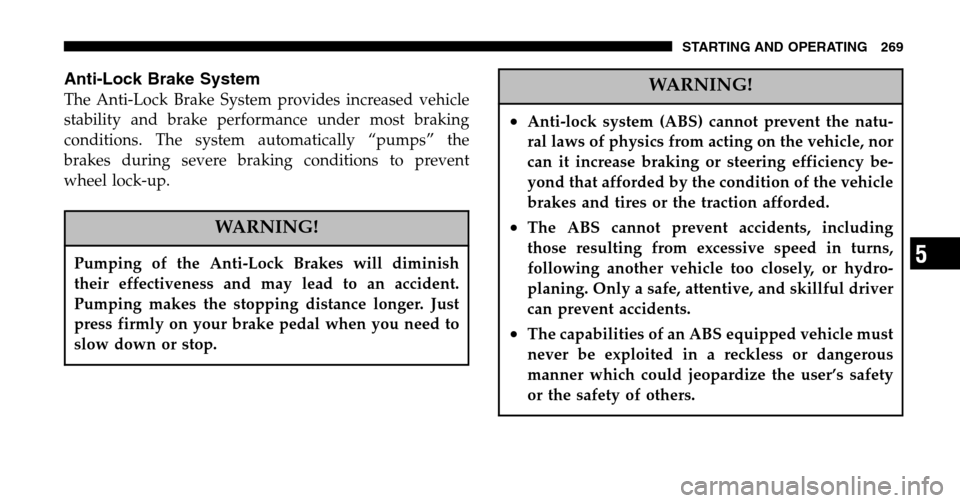Page 256 of 440

▫Tire Markings ........................274
▫ Tire Identification Number (TIN) ..........277
▫ Tire Loading And Tire Pressure ...........278
� Tires—General Information ................282
▫ Tire Pressure .........................282
▫ Tire Inflation Pressures .................283
▫ Radial-Ply Tires ......................285
▫ Compact Spare Tire — If Equipped .........286
▫ Limited Use Spare — If Equipped .........287
▫ Tire Spinning ........................287
▫ Tread Wear Indicators ..................288
▫ Life Of Tire .........................289
▫ Replacement Tires .....................289 ▫
Alignment And Balance .................290
� All Wheel Drive (AWD) — If Equipped .......291
� Tire Pressure Monitor System — If Equipped . . . 291
▫ 1,2,3, Or 4 Tire(s) Low Pressure ...........292
▫ Check TPM System ....................292
▫ General Information ...................293
� Tire Chains ...........................294
� Snow Tires ...........................295
� Tire Rotation Recommendations ............295
� Fuel Requirements ......................296
▫ Reformulated Gasoline .................297
▫ Gasoline/Oxygenate Blends ..............297
▫ MMT In Gasoline .....................298
256 STARTING AND OPERATING
Page 257 of 440

▫Materials Added To Fuel ................298
▫ Fuel System Cautions ..................298
▫ Carbon Monoxide Warnings ..............299
� Adding Fuel ..........................300
▫ Fuel Filler Cap (Gas Cap) ...............300
� Vehicle Loading ........................302
▫ Vehicle Certification Label ...............302
▫ Gross Vehicle Weight Rating (GVWR) .......302
▫ Gross Axle Weight Rating (GAWR) .........302
▫ Overloading .........................303
▫ Loading ............................303 �
Trailer Towing .........................304
▫ Common Towing Definitions .............305
▫ Trailer Hitch Classification ...............307
▫ Trailer Towing Weights (Maximum Trailer
Weight Ratings) ......................307
▫ Trailer And Tongue Weight ..............308
▫ Towing Requirements ..................310
▫ Towing Tips .........................314
� Recreational Towing (Behind Motorhome, Etc.) . . 315
▫ Towing This Vehicle Behind Another Vehicle
(Flat Towing With All Four Wheels On The
Ground) ............................315
STARTING AND OPERATING 257
5
Page 266 of 440

•If the system detects a problem it will disable the
AutoStick mode and the transmission will return to
the automatic mode until the problem is corrected.
ALL WHEEL DRIVE — IF EQUIPPED
This feature provides full time, on-demand, All Wheel
Drive (AWD). The system is automatic with no driver
inputs or additional driving skills required. Under nor-
mal driving conditions, the front wheels provide most of
the traction. If the front wheels begin to lose traction,
power is shifted automatically to the rear wheels. The
greater the front wheel traction loss, the greater the
power transfer to the rear wheels.
CAUTION!
All wheels must have the same size and type tires.
Unequal tire sizes must not be used. Unequal tire
size may cause failure of the power transfer unit
and/or the viscous coupling.
PARKING BRAKE
When the parking brake is applied with the ignition
switch on, the brake light in the instrument cluster will
turn on.
NOTE: This light only shows that the parking brake is
applied. It does not show the degree of brake application.
266 STARTING AND OPERATING
Page 267 of 440
Before leaving the vehicle, make sure that the parking
brake is fully applied and place the gear selector in the
Park position. To release the parking brake, pull out on
the parking brake release located on the left side of the
instrument panel. When parking on a hill, it is important to set the parking
brake before placing the gear selector in Park, otherwise
the load on the transmission locking mechanism may
make it difficult to move the selector out of park. As an
added precaution, turn the front wheels toward the curb
on a downhill grade and away from the curb on a uphill
grade.
The parking brake should always be applied when the
driver is not in the vehicle.
Parking Brake Release
STARTING AND OPERATING 267
5
Page 269 of 440

Anti-Lock Brake System
The Anti-Lock Brake System provides increased vehicle
stability and brake performance under most braking
conditions. The system automatically “pumps” the
brakes during severe braking conditions to prevent
wheel lock-up.
WARNING!
Pumping of the Anti-Lock Brakes will diminish
their effectiveness and may lead to an accident.
Pumping makes the stopping distance longer. Just
press firmly on your brake pedal when you need to
slow down or stop.
WARNING!
•Anti-lock system (ABS) cannot prevent the natu-
ral laws of physics from acting on the vehicle, nor
can it increase braking or steering efficiency be-
yond that afforded by the condition of the vehicle
brakes and tires or the traction afforded.
•The ABS cannot prevent accidents, including
those resulting from excessive speed in turns,
following another vehicle too closely, or hydro-
planing. Only a safe, attentive, and skillful driver
can prevent accidents.
•The capabilities of an ABS equipped vehicle must
never be exploited in a reckless or dangerous
manner which could jeopardize the user’s safety
or the safety of others.
STARTING AND OPERATING 269
5
Page 271 of 440

•and a slight drop or fall away of the brake pedal at the
end of the stop.
These are all normal characteristics of ABS.
WARNING!
The Anti-Lock Brake System contains sophisticated
electronic equipment that may be susceptible to
interference caused by improperly installed or high
output radio transmitting equipment. This interfer-
ence can cause possible loss of anti-lock braking
capability. Installation of such equipment should be
performed by qualified professionals.
All vehicle wheels and tires must be the same size and
type and tires must be properly inflated to produce
accurate signals for the computer.
POWER STEERING
The standard power steering system will give you good
vehicle response and increased ease of maneuverability
in tight spaces. The system will provide mechanical
steering capability if power assist is lost.
If for some reason, the power assist is interrupted, it will
still be possible to steer your vehicle. Under these condi-
tions you will observe a substantial increase in steering
effort, especially at very low vehicle speeds and during
parking maneuvers.
NOTE: Increased noise levels at the end of the steering
wheel travel are considered normal and does not indicate
that there is a problem with the power steering system.
Upon initial start-up in cold weather, the power steering
pump may make noise for a short period of time. This is
due to the cold, thick fluid in the steering system. This
noise should be considered normal, and does not in any
way damage the steering system.
STARTING AND OPERATING 271
5
Page 272 of 440
WARNING!
Continued operation with reduced power steering
assist could pose a safety risk to yourself and others.
Service should be obtained as soon as possible.
CAUTION!
Prolong operation of the steering system at the end
of the steering wheel travel will increase the steering
fluid temperature and should be avoided when
possible. Damage to the power steering pump may
occur.
TRACTION CONTROL — IF EQUIPPED
The Traction Control System reduces wheel slip and
maintains traction at the driving (front) wheels. The
system reduces wheel slip by engaging the brake on the
wheel that is losing traction (spinning). The system will
operate at speeds below 35 mph (56 km/h).
The system is always in the “stand by” mode unless,
•The Traction Control Switch has been used to turn the
system OFF
272 STARTING AND OPERATING
Page 285 of 440
loading may be required for high speed vehicle opera-
tion. Refer to original equipment or an authorized tire
dealer for recommended safe operating speeds, loading
and cold tire inflation pressures.
WARNING!
High speed driving with your vehicle under maxi-
mum load is dangerous. The added strain on your
tires could cause them to fail. You could have a
serious accident. Don’t drive a vehicle loaded to the
maximum capacity at continuous speeds above 75
mph (120 km/h).
Radial-Ply Tires
WARNING!
Combining radial ply tires with other types of tires
on your vehicle will cause your vehicle to handle
poorly. The instability could cause an accident. Al-
ways use radial ply tires in sets of four (or 6, in case
of trucks with dual rear wheels). Never combine
them with other types of tires.
Cuts and punctures in radial tires are repairable only in
the tread area because of sidewall flexing. Consult your
authorized tire dealer for radial tire repairs.
STARTING AND OPERATING 285
5